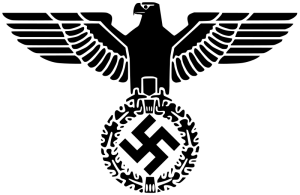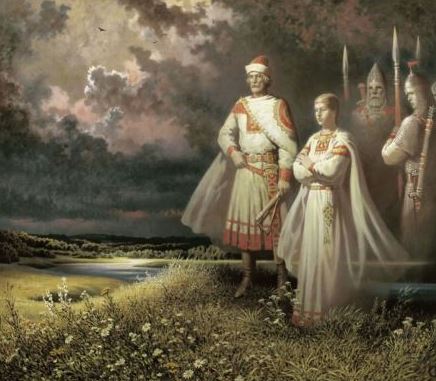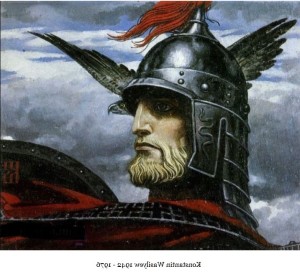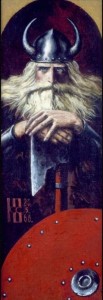… He was described as “… a man of excellent breeding, moral rectitude and industry, upright, courageous…” – a “… moral compass for others”. Professor Haushofer, his mentor, said that his strength was not so much intelligence as heart and character…
Rudolf Hess: The Führer’s Deputy
What secret did he take to the grave?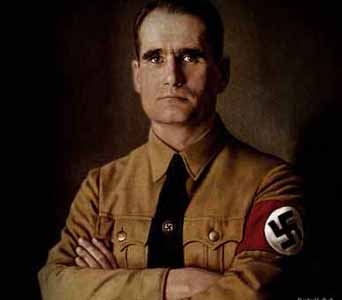
Saturday, August 13th, 2011 | Posted by Dr. Ingrid Rimland Zundel
Until just a few weeks ago, an old man’s bones lay buried in a family grave in an impeccably kept cemetery in a Bavarian town called Wunsiedel. His name was Rudolf Hess. Born 1894, he suffered a mysterious death in 1987 at age 93.
Twenty-four years later, in the dark of the night of 20 July 2011, some ghouls dug up his remains, as well as the bones of his wife and his parents, and holocausted them.
Now who would want to do a ghoulish thing like that? Dracula? Some spiteful force beyond our comprehension that needs to drive a silver stake into the spirit of a man long gone – whose very memory still carries the pulse beat of an era we are not ever to investigate, much less to honor and respect?
David Irving, known even to his friends as the “reluctant Revisionist”, who, brilliant writer that he is, cannot resist to take a verbal swipe or two at twelve short years that ought to awe us at the very least with their scientific marvels, wrote this in introducing “Rudolf Hess: The Missing Years 1941-45”, Grafton Books, 1989:
“Semi-blind, his memory gone, he languished for 46 years in prison, and spent over half of that time in solitary confinement. At first, he was detained in cells with blackened windows, sentinels flashing torches on his face all night at half-hour intervals, and later in conditions only marginally more humane.
“Occasionally, mankind remembered that he was there: at a time when political prisoners were being released as a token of humanity, the world knew that he was there in Spandau, and timid souls felt somehow the safer for it. In 1987 the news emerged that somebody had recently stolen the prisoner’s 1940s flying helmet, goggles, and fur-lined boots, and fevered minds imagined that these, his hallowed relics of 1941, might be used in some way to power a Nazi revival.
“The prisoner himself had long forgotten what those relics had ever meant to him. The dark-red brick of Spandau prison in West Berlin was crumbling and decaying around him, and the windows were cracked or falling out of mouldering frames. He was the only prisoner left – alone, outliving all his fellows, his brain perhaps a last uncertain repository of names and promises and places, grim secrets that the victorious Four Powers might have expected him to take to the grave long before.
“The prisoner was Rudolf Hess, the last of the “war criminals.” In May 1941 he had flown single-handedly to Scotland on a reckless parachute mission to end the bloodshed and bombing. Put on trial by the victors, he had been condemned to imprisonment in perpetuity for “Crimes against the Peace.” The Four Powers had expected him to die and thus seal off the wells of speculation about him, but this stubborn old man with the haunting eyes had by his very longevity thwarted them.
“Few questions remained about the other Nazis. Hitler’s jaw bone was preserved in a Soviet glass jar; Ley’s brain was in Massachusetts; Bormann’s skeleton was found beneath the Berlin cobblestones; Mengele’s mortal remains were dis- and reinterred; Speer had joined the Greatest Architect. Dead, too, were Hess’s judges and prosecutors.
Hess himself was the last living Nazi giant, the last enigma, unable to communicate with the outside world, forbidden to talk with his son about political events, his diary taken away from him each day to be destroyed, his letters censored and scissored to excise illicit content. The macabre Four Powers statute – ignored, in the event – ordained that upon his death his body was to be reduced to ashes in the crematorium at Dachau concentration camp. The bulldozers were already standing by to wreck Spandau jail within hours of his decease, so that no place of Nazi pilgrimage remained.
“For forty years this Berlin charade was the sole remaining joint activity of the wartime Allied powers, a wordless political ballet performed by the Western democracies and high-stepping Red Army guards. Every thirty days the guard was rotated. Each time that the British or the American or the French came to hold the key, they could in theory have turned it and set this old man free. But they did not, because the ghosts of Churchill, Stalin, and Roosevelt were themselves the jailers. In the name of a Four Power agreement that had long since been dishonored, these ghosts kept Hess behind bars; and so Hitler’s deputy lived on in Spandau, mocking history and making a mockery of justice itself.
“Despite everything, he became a martyr to a cause. Mankind dared not turn the key to set him free, and mankind did not know why.”
In this essay, I will speculate why. I claim no certainty. What I am writing is strictly conjecture, stitched together from an intriguing pattern of clues. Conventional wisdom has it that the proposal that Hess tried to take to Britain in 1941 was Hitler’s more than generous offer to prevent the ominous bloodshed that would descend on Europe in years to come exactly as the Führer feared, and that even now enough geopolitical and financial investments are still at risk, embedded in the Order that we know, that would embarrass the Powers entrenched in London, New York, and Tel Aviv.
I offer an alternative guess – that Hess was kept from informing the world what he knew, was contained in the UFO files in his possession. His briefcase contained something else that is still being kept securely under lock and key. That “something” is widely believed to have been the secrets of Third Reich space exploration.
After all, Hess was the one who was in charge of Hitler’s Antarctic projects that were mysteriously stopped in 1938 when a curtain descended on what, exactly, was found or done beneath the ice – mind-boggling technical advances, raced with great fervor to production once World War II broke out, astounding inventions then known as Flying Saucers, called UFOs today. I speculate, as many do, that Hess might well have meant to offer to factions friendly to the Third Reich within the British government a roadmap to the stars.
Just who was Rudolf Hess?
Born to a wealthy merchant family of German background in Egypt, Hess grew up in palatial surroundings. He enjoyed the finest classical education that money could buy in those years, part of it through private tutoring in Egypt, later on in Switzerland and Britain where he was privileged to mingle with the English-speaking upper crust, even as a youngster fascinated by astronomy. He was described as “… a man of excellent breeding, moral rectitude and industry, upright, courageous…” – a “… moral compass for others”. Professor Haushofer, his mentor, said that his strength was not so much intelligence as heart and character.
Hess became Adolf Hitler’s closest comrade, though by temperament and background they were of a different shade. Hitler was of an iconoclastic nature that had the force of a volcano; Hess was a man of quiet but flawless discernment. Hitler was a pragmatist politically yet utterly uncompromising at the core as to his aims and visions; Hess knew only the rule of his heart.
This is not ever acknowledged today in politically correct society, but Hitler in his early reign projected as seductive warmth of spirit through impeccable manners that were the envy of the rulers of his time, whereas Hess remained reticent and private by nature, not a man out to woo attention and favors for himself.
In a staid and placid world, Hess might well have been the Führer’s superior by virtue of social position alone, but in the Twenties and the Thirties in a Europe coming apart at the seams, there was never a question in either man’s mind who was the leader called by destiny. Hess might have been described as the finest specimen that centuries of culture and sophistication had brought forth, but Hitler was the avatar, on a trajectory like every immense persona who is guided from within, and Hess was his disciple.
After hearing Hitler speak in the spring of 1920, Hess joined the National Socialist movement as member # 16. He knew that he had met a man of a gigantic strength of will combined with a magnetic radiance.
The trust in each other these two young men enjoyed as political comrades was total. Maybe Hitler never had another friend like Hess he could trust utterly. For his part, Hess saw in Hitler the Messiah against Satan threatening his mother country in the guise of bestial Bolshevism from the East.
Likewise, Hess’s moral standing in the hearts of Germans of his time was absolute. He was commonly referred to as “the Conscience of the Party.” In the Third Reich’s hierarchy, Hess stood third in the chain of command as the leader of the NSDAP, the Nationalsozialistische deutsche Arbeiterpartei. Only Fieldmarshall Hermann Goering enjoyed higher ranking.
Common experiences bound Hess and Hitler as well. Both had honorably served in battle. Both participated in an awkward uprising that history remembers as the Munich Beer Hall Putsch, a coup d’etat against the Weimar Republic that landed them briefly in Landsberg prison where conditions were relaxed for dissidents. There, acting as Hitler’s private secretary, Hess volunteered as stylist and copy editor for Hitler’s book, Mein Kampf, for which world Jewry would never forgive him.
Much nastiness has been claimed, then and since, about the Nazi leadership in general, but I have never read a single word of hate against Hess from his own inner circle. He was feared and persecuted with an inexorable hatred by Jewry. He was kept isolated from human interaction for more than half of his life, beset and tormented like few other men on this earth. Why? What did this man know? What did he try to convey to the world – and was prevented from sharing?
Expanding his background
Rudolf Hess’s path in life was tragedy writ large. In 1941, On the eve of war with the Soviet Union, Hess flew solo to Scotland on a private peace mission in an attempt to ward off the horror to come. Instead, he was arrested by the British government and held incommunicado until the war was over. After the guns fell silent, Hess was handed over to the Nuremberg Tribunal, tried in a political show trial where white became black, found “not guilty of crimes against humanity” but “guilty for conspiring against peace”, and sentenced to life internment at Spandau Prison, although he was in captivity for almost 4 years of the war and thus he was basically absent from it, in contrast to the others who stood accused at Nuremberg.
He was 52 years old when he set foot in Spandau. He lived another 41 years. He died mysteriously in 1987 – as widely advertised, by suicide, as even more widely believed, by murder. Allegedly, the magnanimous peace offer he had in his briefcase, were it to come out, would embarrass the Brits to his day. I belong to a handful of skeptics who suspect he was about to offer something vastly more important, which would have made short shrift of the prevailing political order based on expensive energy provided by the industries we know.
Metapedia, the dissident counterpart website to Wikipedia, describes this failed peace mission as follows:
“Hess planned to meet the Duke of Hamilton and Brandon. He believed Hamilton to be an opponent of Winston Churchill, whom he held responsible for the outbreak of the war. His proposal of peace included returning all the western European countries conquered by Germany to their own national governments, but German police would remain in position. Germany would also pay back the cost of rebuilding these countries. In return, Britain would have to support the war against Soviet Russia. (…)
“Churchill turned down the proposal for peace and held Hess as a prisoner of war in the Maryhill army barracks. Later Hess was transferred to Mytchett Place near Aldershot. The house was fitted out with microphones and sound recording equipment. Frank Foley and two other MI6 officers were given the job of debriefing Hess —”Jonathan”, as he was now known. Churchill’s instructions were that Hess should be strictly isolated and that every effort should be taken to get any information out of him that might be useful.
“Controversy surrounds the case of whether Hitler knew of Hess’ plans to make peace with Britain. It is known that Hess had been getting flying lessons in a personalized Messerschmitt aircraft in the early stages of this preparation. He was accompanied by Hitler’s personal pilot, Hans Baur.
Lured into a trap?
“There is circumstantial evidence which suggests that Hess was lured to Scotland by the British secret service. Violet Roberts, whose nephew, Walter Roberts was a close relative of the Duke of Hamilton and was working in the political intelligence and propaganda branch of the Secret Intelligence Service (SO1/PWE), was friends with Hess’s mentor Karl Haushofer and wrote a letter to Haushofer, which Hess took great interest in prior to his flight.
“According to data published in a book about Wilhelm Canaris, the head of German intelligence, a number of contacts between England and Germany were kept during the war. It cannot be known, however, whether these were direct contacts on specific affairs or an intentional confusion created between secret services for the purpose of deception. (…)
“Certain documents Hess brought with him to Britain were to be sealed until 2017 but when the seal was broken in 1991-92 they were missing. Edvard Bene_, head of the Czechoslovak Government in Exile and his intelligence chief Franti_ek Moravec, who worked with SO1/PWE, speculated that British Intelligence used Haushofer’s reply to Violet Roberts as a means to trap Hess.
“The fact that the files concerning Hess will be kept closed to the public until 2016 does allow the debate to continue, since without these files the existing theories cannot be fully verified.
In his final statement to the court on August 31, 1946 after his conviction, Hess declared in words that are sheer poetry in German but can only be an approximation in English:
“I had the privilege of working for many years of my life under the greatest son my nation has brought forth in its thousand-year history. Even if I could, I would not wish to expunge this time from my life. I am happy to know that I have done my duty toward my people, my duty as a German, as a National Socialist, as a loyal follower of my Führer. I regret nothing. No matter what people may do, one day I shall stand before the judgment seat of God Eternal. I will answer to Him, and I know that He will absolve me.”
After having served in prison for 20 years with other leaders of the Reich, the last two prisoners, Baldur von Schirach and Albert Speer, were released. Hess remained. He was the sole remaining inmate of Spandau Prison for yet another 21 years.
Metapedia reports:
“Keeping one man in Spandau cost the West German government about 850,000 marks a year. In addition, each of the four Allied powers had to provide an officer and 37 soldiers during their respective shifts, as well as a director and team of wardens throughout the entire year. The permanent maintenance staff of 22 included cooks, waitresses and cleaners.
“In the final years of his life, Hess was a weak and frail old man, blind in one eye, who walked stooped forward with a cane. He lived in virtually total isolation according to a strictly regulated daily routine. Regulations stipulated that prison officials could not ever call Hess by name. He was addressed only as “Prisoner No. 7.”
During his rare meetings with his wife and son, Hess was not allowed to embrace or even touch them. Why this inhuman cruelty?
Of the four powers that had won the war against Germany, three – the U.S., Russia, and France – proposed that he be released on humanitarian grounds due to his age. The British government balked. Thatcher was Prime Minister of Britain, and Chancellor Kohl – some call him Cohn or Cohen – was heading Germany.[Ron: Remember the British government was/is controlled directly by the sovereign City of London under the Rothschilds and the Bolshevik Jews were finally evicted from the Soviet ynion in 1977 so the Christians who gained control in Russia would not have had any grudge against Hess or Hitler.]
On 17 August 1987, Hess died while under Four Power imprisonment at Spandau Prison in West Berlin. At 93, he was one of the oldest prisoners in the world. He was found in a summer house in a garden located in a secure area of the prison with an electrical cord wrapped around his neck. His death was ruled a suicide by self-asphyxiation, accomplished by tying the cord to a window latch in the summer house.[Ron: YEAH RIGHTTT!]
Prison guards who knew him in his last years say that he was so crippled by arthritis that he could not lift his arms above his shoulders. No way could this old man have strangled himself.
Hess was buried in Wunsiedel, and Spandau Prison was subsequently demolished to prevent it from becoming a shrine. Instead, his grave became exactly that.
Metrapedia continues:
“Every year after Hess’s death, nationalists from Germany and the rest of Europe gathered in Wunsiedel for a memorial march. Similar demonstrations took place around the anniversary of Hess’s death. These gatherings were banned from 1991 to 2000 and nationalists tried to assemble in other cities and countries (such as the Netherlands and Denmark). Demonstrations in Wunsiedel were again legalised in 2001. Over 5,000 nationalists marched in 2003, with around 7,000 in 2004, marking some of the biggest national demonstrations in Germany since 1945. After stricter German legislation regarding demonstrations by nationalists was enacted in March 2005 the demonstrations were banned again.
It has often been said that a people defeated, besieged from all sides but not neutered, , will keep its myths alive. I have been told a few. One of them has it that the Führer is said to have insisted that there would be one “Last Battalion” that would come back after certain defeat and would finish what he himself could not do. That “Last Battalion” would be German.


